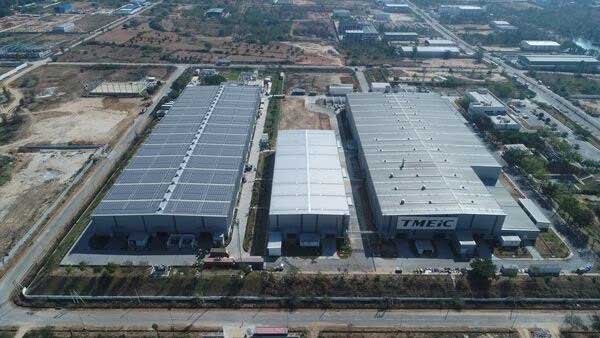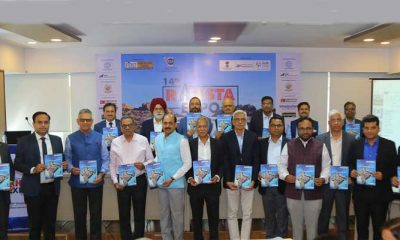Economy & Market
Opportunities galore
Published
6 years agoon
By
admin
Greening of industry is a method to attain sustainable economic growth and promote sustainable economies. It includes policymaking, improved industrial production processes and resource-efficient productivity.
The United Nations Industrial Development Organization (UNIDO) can be given credit of coining the term Green Industries Initiatives. A few years back, UNIDO coined the concept ‘Green Industry’ to place sustainable industrial development in the context of new global sustainable development challenges. Green industry means economies striving for a more sustainable pathway of growth, by undertaking green public investments and implementing public policy initiatives that encourage environmentally-responsible private investments.
Green Industry Initiatives create awareness, knowledge and capacities about what is sustainable. UNIDO works with different governments to support industrial institutions that in turn provide assistance to enterprises and entrepreneurs in all aspects relating to the greening of industry. As an organisation, UNIDO extends support for integrating corporate social responsibility, water management, energy and promotion of eco-friendly processes into the policy framework of an industry.
On the other hand, industrial pollution is generally referred to the undesirable outcome when factories emit harmful by-products and waste into the environment such as emissions to air or water bodies (water pollution), deposition on landfills etc. (land pollution) or emission of toxic chemicals into the atmosphere.
Earth’s atmosphere is a dynamic system of natural gases that are necessary to sustain life, and while it has a defence mechanisms to absorb small quantities of air pollutants, high levels of gases can cause ozone depletion and other problems for living organisms. The main sources of gaseous air pollutants are fuel combustion in stationary sources, such as coal-burning power plants, as well as emissions from automobiles. While these gases are not the only ones contributing to air pollution, they are regarded as dominant sources of this world-wide problem.Carbon oxides: Carbon monoxide (CO) is a poisonous gas, dangerous due to its lack of odour and colour that is released into the atmosphere with the incomplete combustion of fuels, such as coal, wood or other natural sources, as well as exhaust from automobiles. Carbon dioxide (CO2) is the greenhouse gas widely considered the main air pollutant in the earth’s atmosphere. Despite the fact that carbon dioxide is essential to support living organisms, it is considered a dangerous air pollutant caused by human activities such as deforestation and the burning of fossil fuels.
Responsible for more than half of the global warming trend, carbon dioxide restricts infrared radiation leaving the Earth’s surface, causing the "greenhouse effect."Nitrogen oxides: Nitrogen oxides (NOx) are air pollutants that contribute the most contaminants to the earth’s atmospheric. Like carbon oxides, vehicle emissions are a major source of nitrogen oxides, and these air pollutants are easily recognizable by the brown plume or haze that forms over areas with high concentrations of the gases. Nitrogen dioxide (NO2) is one of the most prominent and dangerous air pollutants, and this toxic gas is easily identifiable by its reddish-brown color and distinctive, sharp odour.Sulphur oxides: Sulphur oxides (SOx) are another group of gases polluting the earth’s atmosphere. Of particular concern is sulphur dioxide (SO2), one of the major components of smog and a primary cause of acid rain. While sulphur dioxide is naturally produced by erupting volcanoes, the combustion of sulphur-containing fuels such as petroleum oils and coal have caused this gas to become a dangerous air pollutant that is eating away at the Earth’s fragile atmosphere. Dangerous to both plants and animals, sulphur oxides can injure organic matter when deposited in high concentrations and cause respiratory problems by irritating air passages and lungs.
On November 8, 2017, Delhi earned the unenviable distinction of becoming the most polluted city on Earth. The pollution surged so high that some monitoring stations reported an Air Quality Index of 999, way above the upper limit of the worst category, hazardous. (An extra-sensitive air quality instrument at the US embassy got a reading of 1,010, as you can see in the chart).
The airborne particles and toxic chemicals that make up the smog had choked the 19 million residents of the metropolitan area, where merely breathing the air was, at its worst, like smoking 50 cigarettes in a day. Hospitals reported a 20 percent surge in patients with pollution-related illnesses, and doctors had declared a public health emergency.
We are bringing out a classic case before the readers just to point out that what reckless industrialisation can bring out. In the entire spectrum of pollutants, automobiles cause the highest pollution then comes the power generating plants and close to that is cement industry. Therefore it is pertinent that cement industry initiates green initiatives. Why to take green steps?
- Cement production is the third ranking producer of anthropogenic (man-made) CO2 in the world after transport and energy generation
- About 4 – 5 per cent of the worldwide total of CO2 emissions is caused by cement production
- CO2 is produced at two points during cement production:
- The first is as a by-product of burning of fossil fuels, primarily coal, to generate the heat necessary to drive the cement-making process. The second from the thermal decomposition of calcium carbonate in the process of producing cement clinker.
- CaCO3 (limestone) + heat -> CaO (lime) + CO2
- Production of one tonne of cement results in 780 kg of CO2
- Of the total CO2 output, 30 per cent derives from the use of energy and 70 per cent results from de-carbonation
Important to realise is that although 5 per cent of the worldwide generation of CO2 is due to cement production, that level of output also reflects the unique and universal importance of concrete throughout the construction industry.Measures adopted by cement
The emission regulations moved from 250 mg/Nm3 to 30 mg/Nm3 progressively on par with the global best practices. The cement Industry is continuously adapting to the latest air pollution control technologies like Electrostatic Precipitators, Bag Filters for achieving lower stack emissions of 30 mg/Nm3. Cement Industry installed Continuous Emission Monitoring Systems and Continuous ambient air quality monitoring stations for on line reporting dust emissions. The provisions of Air (Prevention and Control of Pollution) Act, 1981, National Ambient Air Quality Standards has accelerated the Cement Industry’s efforts to pursue their initiatives more vigorously.Measures to control of water pollution: Cement Industry installed Sewage Treatment Plants and Effluent Treatment Plants to treat this water and to reuse for dust suppression & gardening. It is also doing huge amount of rain water harvesting in their mined out pits. Corporates like ACC, Ambuja and Dalmia Bharat have taken steps at few of their plants to become water positive. Sustainable mining and biodiversity conservation: All captive mines operated by Cement Industry strictly adhere to mining, environmental norms laid by Indian Bureau of Mines, Ministry of Environment & Forest & Climate Control , State Pollution Control Board for eco-friendly mining and safety norms by Directorate General of Mines Safety (DGMS) for safe mining. All cement plant and mine sites complies with earmarking 33 per cent of total land area for the green belt development and afforestation. Wild Life Protection Act (WPA) 1972 is further augmenting the Cement Industry’s efforts in preserving the biodiversity with clear guidance. Hazardous waste management & co-processing:Cement industry generates very limited quantity of hazardous waste such as spent oils and lubricants, grease, etc., which are either co-processed in cement kilns or sold to authorised recyclers. The Hazardous Waste (Management, Handling and Transboundary Movement) Rules, 2008 & amendment 2010 gives a clear guidance to the Industry for safe management, handling and disposal of hazardous waste. Apart from this industry also co-process various waste materials generated by other industry. The kiln of a cement plant is the best suited for processing of waste in the most cost effective manner which none other system offers world over. Today rapid urbanisation has created several problems of disposing off waste either industrial or domestic. The stock of fossil fuels is depleting very fast, we have to look for another source of energy. Therefore processing of waste in cement kilns has vast potential in our country. The technology as such is quite proven in Europe and other advance countries. We need to adapt it to local conditions. TSR (Thermal Substitution Rate) is a per cent age replacement of conventional fuel and the number for some of the countries is as high as 60 per cent where as in our case it is at meagre 4 per cent.
Apart from the above, the cement industry has following various innovations towards the sustainable development. Equipment Innovation: Cement
Industry has taken various energy conservation activities throughout the cement manufacturing process. Some of the notable initiatives are as given are
as under:
- Advanced dry process kiln with energy efficient cooler with 6/7 stage pre heater
- Low NOX burners and low NOX calciners to reduce NOX from the kiln
- Energy-efficient grinding equipment like roller press and VRMs
- Energy efficient compressors, pumps, lighting, variable speed drives, fans and motors
- Process optimiser along with advanced energy management system, etc.,
Clinker factor improvement and natural resources conservation: Total cement grade limestone reserve available to meet the industry requirements is 89.86 billion tonne, which are expected to last only for another 40 years. Cement industry has carried out extensive research and development for substituting clinker and to absorbs huge quantities of industrial wastes like fly ash and slag. This not only helps in reduction in CO2 emission but also preserving natural resources like limestone and corrective materials.
Recycling of concrete as of date happens to be far stretched. Concrete mixture has the highest proportion of natural materials like stone chips, sand, water etc. If we are able to make use of used concrete we shall save our natural sources of sand and stones. Cement industry is expected to make investments in processing of used concrete which is not happening. With focus on infra development, the day is not far away when we shall be compelled to explore these options. With confidence we can say that Indian cement industry is on the right track though may be little late on few initiatives. The days ahead of us will see industry becoming greener.
Economy & Market
RAHSTA to showcase cutting-edge road construction tech, says NCC Director
Published
5 days agoon
April 19, 2024By
admin
14th RAHSTA (Roads and Highways Sustainable Technologies & Advancement) Expo – India’s biggest road exhibition – will be held as a part 10th India Construction Festival 2024 at Jio Convention Centre, Mumbai, from October 9-10, 2024.
April 10, 2024, Delhi
“The RAHSTA expo will offer extensive information about the latest technology and methods for constructing high-quality roads. Currently, the challenge facing the roads industry is to uphold road quality and execute projects efficiently. RAHSTA will provide opportunities for everyone to learn about the latest worldwide technologies and equipment available, undoubtedly offering valuable insights to those involved in the roads sector,” said Vinod Kumar Yadav, Director – Transport, NCC, and former Chairman, Railway Board, while speaking during the launch of a road show – 14th RAHSTA Expo, which will be held from October 9-10, 2024, at Jio Convention Centre, Mumbai.
RAHSTA, which stands for Roads and Highways Sustainable Technologies & Advancement, is a dedicated event to the world of road construction equipment, technology, and sustainability.
“The Ministry of Road Transport & Highways has constructed 12,349 km of national highways in 2023-24 – the second highest achievement! In 2020-21 a record 13,327 kms had been constructed, the highest so far. The experience of a well-constructed road is no accident but a badly constructed one can cause many,” stated Pratap Padode, Founder, FIRST Construction Council, a pioneering infrastructure-driven council focused on advancing India’s infrastructure development.
Also speaking at the launch, former Managing Director of Ashok Leyland & JCB, Vipin Sondhi, also Chairman of RAHSTA Expo Committee underscored the need for specialised platforms like RAHSTA Expo for the burgeoning road construction industry.
Ashish Kumar Singh, CGM – Finance, National Highway Authority of India; RK Pandey, former NHAI member and Member of RAHSTA Expo Committee; SK Nirmal, Secretary General, Indian Roads Congress and Member of RAHSTA Expo Committee; Prof Satish Pandey, Principal Scientist, CSIR-Central Road Research Institute, Ministry of Science and Technology; Ankit Jain, CFO, Cube Highways Growth Advisors, Vijay Agrawal, Executive Director, Equirus Capital; and Subodh Dixit, Former Executive Director, Shapoorji Pallonji, participated in a round table discussion on the new BOT proposals.
The launch function at PHD Chamber for RAHSTA Expo was attended by who’s who of the infrastructure industry such Lt Gen Harpal Singh, President, International Road Federation and former Engineer-in-Chief, Indian Army; Akhilesh Srivastava, Road Safety Ambassador, International Road Federation; Sandeep Singh, Managing Director, Tata Hitachi Construction Machinery; Rajesh Menon, Director General, Society of Indian Automobile Manufacturers; Raman Kapil, President, Tata Projects; Anand Sundaresan, Director, Ammann India; Dheeraj Panda, Managing Director, Ammann India; Rajan Aiyer, Managing Director, Trimble; Satin Sachdeva, Founder & Secretary General, Construction Equipment Rental Association; Dr Swamy, Chairman, The Institution of Civil Engineers and Dr Ranjeet Mehta, Executive Director of PHDCCI, among others.
Organised by the FIRST Construction Council, the RAHSTA Expo 2024, which will be held as part of 10th India Construction Festival, will bring together industry leaders, innovators, and stakeholders for two days of exploration, collaboration, and transformation.

Besides RAHSTA Expo 2024, the India Construction Festival 2024 will include the following:
- 14th India RAHSTA(Roads) Conference
- 12th Equipment India Awards
- 22nd Construction World Global Awards
Exhibitors can use RAHSTA Expo 2024 to showcase their construction machinery, building material machines, mining machines, and construction vehicles to a targeted audience of industry professionals. RAHSTA Expo will be an ideal platform to connect with key decision-makers, generate leads, and grow business in this rapidly expanding market.
Contact:
For exhibitor enquiries (for RAHSTA Expo), contact Mr Sujoy on Mob: +91 86577 95881, or Email: sujoy.g@asappinfoglobal.com
For delegate enquiries (for conferences), contact Mr Amar on Mob: +91 86524 93000, or Email: delegate1@asappinfoglobal.com
Economy & Market
RAHSTA will drive road construction innovation: Sundaresan
Published
6 days agoon
April 18, 2024By
admin
14th RAHSTA (Roads and Highways Sustainable Technologies & Advancement) Expo – India’s biggest road exhibition – will be held as a part 10th India Construction Festival 2024 at Jio Convention Centre, Mumbai, from October 9-10, 2024.
April 10, 2024, Delhi
“We believe RAHSTA is the ideal platform for our presence, and we are confident in our participation in the upcoming expo scheduled for October,” said Anand Sundaresan, Director, Ammann India, while speaking during the launch of a road show – 14th RAHSTA Expo, which will be held from October 9-10, 2024, at Jio Convention Centre, Mumbai. RAHSTA, which stands for Roads and Highways Sustainable Technologies & Advancement, is a dedicated event to the world of road construction equipment, technology, and sustainability.
Sundaresan added, “We predominantly specialise in road construction machinery, such as asphalt plants, concrete batching plants, pavers, and rollers, among others. Additionally, we offer ancillary equipment like supers. With the government placing significant emphasis on infrastructure development, there is a substantial demand for road construction machinery. Particularly noteworthy is the growth witnessed in the last year (2023-2024), with a surge in orders. Moreover, the construction of airports is underway, necessitating equipment for runway construction. We perceive immense potential and opportunity for growth within the industry.”
“The Ministry of Road Transport & Highways has constructed 12,349 km of national highways in 2023-24 – the second highest achievement! In 2020-21 a record 13,327 kms had been constructed, the highest so far. The experience of a well-constructed road is no accident but a badly constructed one can cause many,” stated Pratap Padode, Founder, FIRST Construction Council, a pioneering infrastructure-driven council focused on advancing India’s infrastructure development.
Padode was speaking at the launch of a road show – 14th RAHSTA Expo, which will be held from October 9-10, 2024, at Jio Convention Centre, Mumbai. RAHSTA, which stands for Roads and Highways Sustainable Technologies & Advancement, is a dedicated event to the world of road construction equipment, technology, and sustainability.
Speaking at the launch, former Managing Director of Ashok Leyland & JCB, Vipin Sondhi, also Chairman of RAHSTA Expo Committee underscored the need for specialised platforms like RAHSTA Expo for the burgeoning road construction industry.
Ashish Kumar Singh, CGM – Finance, National Highway Authority of India; RK Pandey, former NHAI member and Member of RAHSTA Expo Committee; SK Nirmal, Secretary General, Indian Roads Congress and Member of RAHSTA Expo Committee; Prof Satish Pandey, Principal Scientist, CSIR-Central Road Research Institute, Ministry of Science and Technology; Ankit Jain, CFO, Cube Highways Growth Advisors, Vijay Agrawal, Executive Director, Equirus Capital; and Subodh Dixit, Former Executive Director, Shapoorji Pallonji, participated in a round table discussion on the new BOT proposals.
The launch function at PHD Chamber for RAHSTA Expo was attended by who’s who of the infrastructure industry such Lt Gen Harpal Singh, President, International Road Federation and former Engineer-in-Chief, Indian Army; Akhilesh Srivastava, Road Safety Ambassador, International Road Federation; Sandeep Singh, Managing Director, Tata Hitachi Construction Machinery; Rajesh Menon, Director General, Society of Indian Automobile Manufacturers; Raman Kapil, President, Tata Projects; Anand Sundaresan, Director, Ammann India; Dheeraj Panda, Managing Director, Ammann India; Rajan Aiyer, Managing Director, Trimble; Satin Sachdeva, Founder & Secretary General, Construction Equipment Rental Association; Dr Swamy, Chairman, The Institution of Civil Engineers and Dr Ranjeet Mehta, Executive Director of PHDCCI, among others.
Organised by the FIRST Construction Council, the RAHSTA Expo 2024, which will be held as part of 10th India Construction Festival, will bring together industry leaders, innovators, and stakeholders for two days of exploration, collaboration, and transformation.
Besides RAHSTA Expo 2024, the India Construction Festival 2024 will include the following:
- 14th India RAHSTA(Roads) Conference
- 12th Equipment India Awards
- 22nd Construction World Global Awards
Exhibitors can use RAHSTA Expo 2024 to showcase their construction machinery, building material machines, mining machines, and construction vehicles to a targeted audience of industry professionals. RAHSTA Expo will be an ideal platform to connect with key decision-makers, generate leads, and grow business in this rapidly expanding market.
Contact:
For exhibitor enquiries (for RAHSTA Expo), contact Mr Sujoy on Mob: +91 86577 95881, or Email: sujoy.g@asappinfoglobal.com
For delegate enquiries (for conferences), contact Mr Amar on Mob: +91 86524 93000, or Email: delegate1@asappinfoglobal.com

TMEIC Industrial Systems India, a Group company of TMEIC Corporation, Japan, has announced the appointment of Hidekazu Matsushima as the new Managing Director. Matsushima has been associated with Mitsubishi Electric FA division for domestic market in Japan since 1991 and been assigned in Industrial division in 1994, where he rolled out his mission of sales, marketing and business development of General industry (GI) such as paper, film, Oil & Gas, petrochemical, cement, food, automobile, semiconductor industries in Japan. During the establishment of TMEIC in Japan in 2003, he was assigned with the responsibility for domestic GI market Sales in Japan HQ, and then in plant and energy sales department.

RAHSTA to showcase cutting-edge road construction tech, says NCC Director

RAHSTA will drive road construction innovation: Sundaresan

New appointment at TMEIC

Social Impact Award for Ambuja Cements

UCWL unveils new plant in Dabok, Udaipur

Environment Ministry revises rules of solid waste management

M-sand boards new terrain

Process and quality optimization in cement plant.
Concrete: A Highly Sustainable Building Material

Adani Group eyes Jaiprakash Associates’ Shahabad cement plant
Trending News
-

 Economy & Market2 weeks ago
Economy & Market2 weeks agoRoad construction industry to launch RAHSTA Expo 2024
-

 Concrete1 week ago
Concrete1 week agoFiltration can help to control climate change
-

 Economy & Market2 weeks ago
Economy & Market2 weeks agoRoad construction leaders launch RAHSTA Expo 2024 in Delhi
-

 Economy & Market2 weeks ago
Economy & Market2 weeks agoRoad construction industry launches RAHSTA Expo 2024 in Delhi





